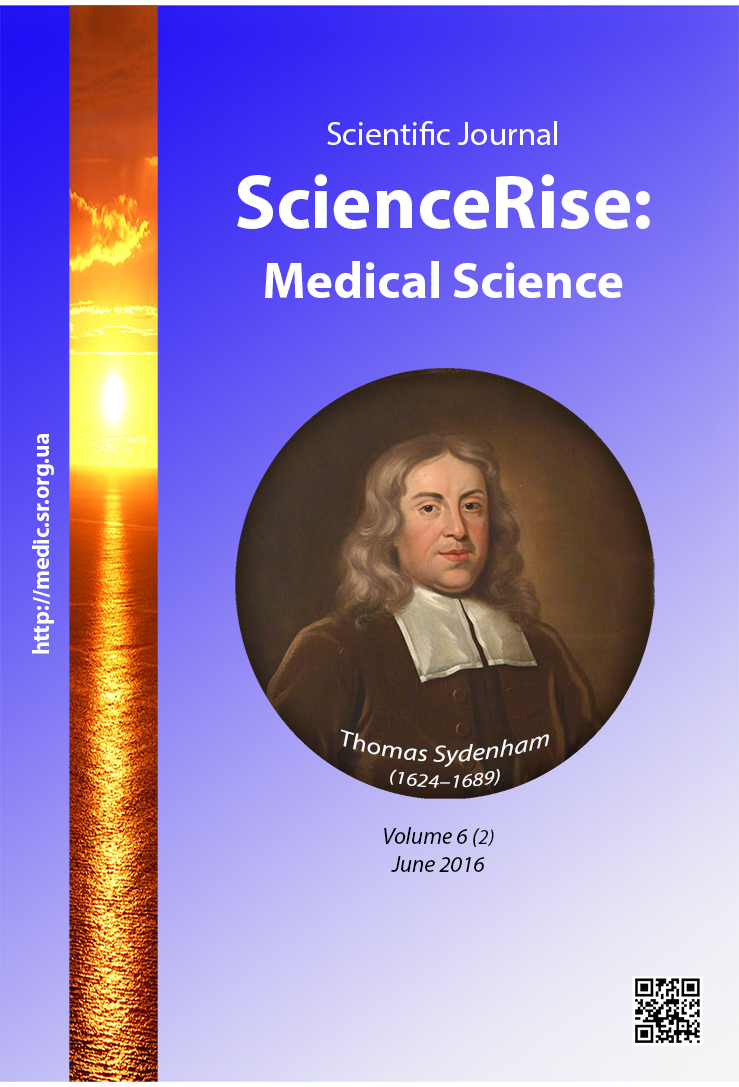Effect of vacuum therapy on reparative tissue regeneration in wound area
DOI:
https://doi.org/10.15587/2519-4798.2016.72045Keywords:
purulent surgical infection, vacuum therapy, tissues reparative regeneration, proliferative indexAbstract
Aim of research was to study the influence of a low-dose vacuum therapy, as the most effective method for local wound treatment, on reparative tissue regeneration, compared with the traditional treatment methods. The object of research was patients with purulent surgical diseases of soft tissues. The subject of study was changes in dynamics of tissues proliferative activity.
Methods: the control group consisted of patients with purulent surgical diseases (16 patients), being examined comprehensively and treated by the traditional scheme. The main group consisted of patients with purulent surgical diseases (16 patients), in which a low-dose vacuum therapy method was used for local wound treatment.
Results. The obtained results show high reparative effect of a low-dose vacuum on wound area tissues, due to proliferative processes activation in wound. The effect of the negative pressure on wound area tissues leads to increasing the amount of cells in high proliferative activity, which activates reparative processes in wound defect area.
Conclusion. The use of immunohistochemistry method for determination of the reparative regeneration level in tissues at KI 67 antigen expression study allows evaluating objectively the level of proliferative activity and give guidelines for wound closure this or that way
References
- VIltsanyuk, O. A., Hutoryanskiy, M. O. (2012). SuchasnI pIdhodi do kompleksnogo lIkuvannya gnIyno - zapalnih protsesIv ta pIslyaoperatsIynih gnIynih uskladnen [Current approaches to complex treatment of inflammatory processes and postoperative suppurative complications]. KlInIchna hIrurgIya, 11, 6.
- Haritonov, Yu. M., Frolov, I. S. (2014). Novyie tehnologii v lechenii bolnyih odontogennoy gnoynoy infektsiey [New technologies in treatment of patients with purulent odontogenic infection]. Fundamentalnyie issledovaniya, 7-3, 582–585.
- Abaev, Y. K. (2010). Problema infektsii v hirurgii [The problem of infection in the surgery]. Meditsinskie novosti, 5-6, 6–11.
- Shablovskaya, T. A., Panchenkov, D. N. (2013). Sovremennyie podhodyi k kompleksnomu lecheniyu gnoyno-nekroticheskih zabolevaniy myagkih tkaney [Modern approaches to integrated management of necrotic soft tissue diseases]. Vestnik eksperimentalnoy i klinicheskoy hirurgii, 4, 498–518.
- Dronov, A. I., Skomarovskiy, A. A., Kolesnik, V. A., Kravchenko, A. V., Sotnik, Yu. I. (2013). Sovremennyie podhodyi k lecheniyu ran v zavisimosti ot faz ranevogo protsessa [Current approaches to the treatment of wounds, depending on the phases of wound healing]. Shpitalna hIrurgIya, 2, 68–69.
- Aggarwal, Н., Singh, M. P., Nahar, P., Mathur, H. (2014). Efficacy of low-level laser therapy in treatment of recurrent aphthous ulcers – a sham controlled, split mouth follow up study. Journal of clinical and diagnostic research, 8 (2), 218–221. doi: 10.7860/jcdr/2014/7639.4064
- Phillips, C. J., Humphreys, I., Fletcher, J., Harding, К., Chamberlain, G., Macey, S. (2015). Estimating the costs associated with the management of patients with chronic wounds using linked routine data. International Wound Journal. doi: 10.1111/iwj.12443
- Richmond, N. A., Maderal, A. D., Vivas, A. C. (2013). Evidence-based management of common chronic lower extremity ulcers. Dermatologic Therapy, 26 (3), 187–196.
- Gluhov, A. A., Aralova, M. V. (2015). Patofiziologiya dlitelno nezazhivayuschih ran i sovremennyie metodyi stimulyatsii ranevogo protsessa [Pathophysiology of nonhealing wounds and modern methods of stimulation of wound healing]. Novosti hirurgii, 6, 673–679.
- Kistner, R. L., Shafritz, R., Stark, K. R., Warriner, R. A. (2010). Emerging treatment options for venous ulceration in today’s wound care practice. Ostomy Wound Manage, 1 (56), E1–11.
- Li, Z., Roussakis, E., Koolen, P. G. L., Ibrahim, A. M. S., Kim, K., Rose, L. F. et. al (2014). Non-invasive transdermal two-dimensional mapping of cutaneous oxygenation with a rapid-drying liquid bandage. Biomedical Optics Express, 5 (11), 3748. doi: 10.1364/boe.5.003748
- Anthony, H. (2015). Efficiency and cost effectiveness of negative pressure wound therapy. Nursing Standard, 30 (8), 64–70. doi: 10.7748/ns.30.8.64.s50
- De Leon, J. M., Barnes, S., Nagel, M., Fudge, M., Lucius, A., Garcia, B. (2009). Cost-effectiveness of Negative Pressure Wound Therapy for Postsurgical Patients in Long-term Acute Care. Advances in Skin & Wound Care, 22 (3), 122–127. doi: 10.1097/01.asw.0000305452.79434.d9
- Larichev, А. (2014). At the Beginning of Vacuum Therapy: from the Blood-Sucking Cups to the Bier-Klapp Method. Negative Pressure Wound Therapy, 1 (1), 5–9.
Downloads
Published
How to Cite
Issue
Section
License
Copyright (c) 2016 Алексей Николаевич Велигоцкий, Роман Владимирович Савицкий, Алексей Николаевич Довженко

This work is licensed under a Creative Commons Attribution 4.0 International License.
Our journal abides by the Creative Commons CC BY copyright rights and permissions for open access journals.
Authors, who are published in this journal, agree to the following conditions:
1. The authors reserve the right to authorship of the work and pass the first publication right of this work to the journal under the terms of a Creative Commons CC BY, which allows others to freely distribute the published research with the obligatory reference to the authors of the original work and the first publication of the work in this journal.
2. The authors have the right to conclude separate supplement agreements that relate to non-exclusive work distribution in the form in which it has been published by the journal (for example, to upload the work to the online storage of the journal or publish it as part of a monograph), provided that the reference to the first publication of the work in this journal is included.









